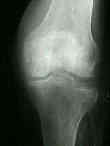- Discussion:
- involves central or peripheral depression of frx of lateral plateau w/o associated lateral wedge fracture;
- it usually occurs from minimal impact on weak osteoporotic bone;
- commonly affects older age groups (55-60 yrs) w/ marked osteoporosis;
- stability of joint is rarely affected & excellent function is expected if there is minimal joint incongruity;
- Radiographs:
- degree of joint involvement may vary, from small central plateau depression to fracture depression involving the whole plateau;
- Non Operative Rx:
- most low energy type III frx in elderly pts w/ poor bone stock should be treated non-operatively;
- if no valgus instability is found, it is safe to treat such a frx, w/ early motion but no wt bearing;
- Operative Rx:
- PreOp Planning
- if surgery is planned, consider properative MRI;
- w/ valgus instability, ORIF is considered;
- if depression is severe, articular fragments should be elevated bone grafted, and the lateral cortex supported with a butress plate;
- w/ central depression frx, lateral cortex is intact circumferentially, & theoretically, there is no need for butress plate;
- consider arthroscopic visualization of frx, use of the ACL guide to assist with the creation of a bone window below the depression;
- the ACL guide, can then assist with elevation of the depressed fragment;
- bone graft is inserted from below, and following this a 6.5 mm cancellous screw is inserted below the graft to provide support;


